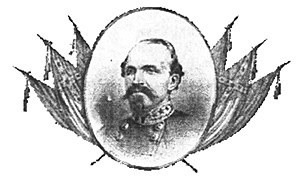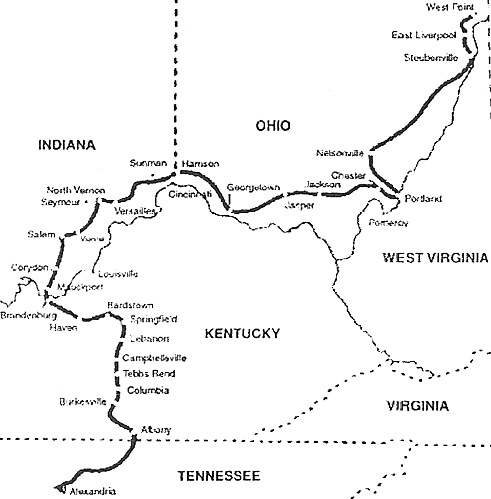 Brig. Gen. John Hunt Morgan's raid is still remembered as time of great excitement and danger in southern Indiana and Ohio. For 46 days as they rode over 1,000 miles, Morgan's Confederates terrorized a region from Tennessee to northern Ohio. His 2,460 handpicked Southern cavalrymen rode west from Sparta in eastern Tennessee on June 11, 1863, intending to divert the attention of the Federal Army of Ohio from Confederate forces in the state. On June 23, the Federal Army of the Cumberland began its operations against Gen. Braxton Bragg's Confederate Army of Tennessee in what became known as the Tullahoma Campaign, and Morgan decided to it was time to move northward.
Brig. Gen. John Hunt Morgan's raid is still remembered as time of great excitement and danger in southern Indiana and Ohio. For 46 days as they rode over 1,000 miles, Morgan's Confederates terrorized a region from Tennessee to northern Ohio. His 2,460 handpicked Southern cavalrymen rode west from Sparta in eastern Tennessee on June 11, 1863, intending to divert the attention of the Federal Army of Ohio from Confederate forces in the state. On June 23, the Federal Army of the Cumberland began its operations against Gen. Braxton Bragg's Confederate Army of Tennessee in what became known as the Tullahoma Campaign, and Morgan decided to it was time to move northward.
On July 2, hoping to disrupt the Yankees' lines of communication, he rode into Kentucky, where admiring citizens openly welcomed his cavalrymen. Crossing the Cumberland River at Burkesville, Morgan's division advanced to the Green River, where it was deflected by a Union regiment at Tebb's Bend on July 4. Morgan soon surprised and captured the garrison at Lebanon, before riding through Springfield, Bardstown, and Garnettsville. Along the way, the Rebels endured several small skirmishes with Yankees and Kentucky home guard units. In a sharp fight near Lebanon, Federal troops killed Morgan's brother Thomas.
By now reduced to 1,800 men, Morgan's column arrived on the morning of July 8 at the small town of Brandenburg along the Ohio River. Here, they seized two steamboats, and Morgan, against Bragg's orders, transported his command across the river to Indiana, landing just east of Mauckport. A small company of Indiana home guards contested the crossing with an artillery piece, as did a riverboat carrying a six-pounder. Morgan chased off the local defenders, capturing a sizeable portion as well as their gun. After burning the captured steamers, Morgan headed away from the river. Gov. Oliver P Morton worked feverishly to organize Indiana's defense, calling for ablebodied men to take up arms and form militia companies. Col. Lewis Jordan took command of the 450 members of the Harrison County Home Guard (Sixth Regiment, Indiana Legion), consisting of poorly trained civilians with a motley collection of arms. His goal was to delay Morgan long enough for Union reinforcements to arrive. Maj. Gen. Ambrose Burnside, commander of the Department of Ohio with headquarters in Cincinnati, quickly organized local Federal troops and home militia to cut off Morgan's routes back to the South.
Morgan headed northward on Mauckport Road, with another brother, Col. Richard Morgan, leading the forward elements. On July 9, one mile south of Corydon, the county seat of Harrison County, his advance guard encountered Jordan's small force, drawn in a battle line behind a hastily thrown up barricade of logs. The colonel attacked, and in a short but spirited battle of less than an hour, he simultaneously outflanked both Union wings, completely routing the hapless militia. Accounts vary as to the number of casualties, but the most reliable evidence suggests that Jordan lost 4 killed, 10-12 wounded, and 355 captured. Morgan counted 11 dead and 40 wounded raiders. Among the dead Yankees was the civilian toll keeper, who perished near his tollgate. Raiders killed a Lutheran minister on his farm, four miles from the battlefield, and stole horses from several other farmers.
General Morgan led his division into Corydon, where he paroled his demoralized prisoners. Gleeful Confederates spent the afternoon plundering stores and collecting ransom money- Morgan threatened to torch three local mills, and demanded amounts ranging from $700 to $1,000 from each to save them from destruction. The county treasurer paid Morgan $690, and two leading stores $600 each. Later that day, the raiders left Corydon and continued their northward ride, scouring the countryside to collect fresh horses and additional booty. The Rebels turned eastward and entered Ohio on July 13, destroying bridges,, railroads, and government stores. Morgan's Raid spread terror across southern and central Ohio.
Federal columns and gunboats converged to prevent Morgan from recrossing the Ohio River into Kentucky, and near the Buffmgton Island ford, Union troops won a decisive victory and captured the bulk of Morgan's men, including his brother Richard and noted cavalryman Col. Basil Duke. The general and his 400 remaining cavaliers escaped, and eventually crossed the Muskingum River south of Zanesville before turning northward in Guernsey County. Yankee forces finally caught Morgan on July 26 near New Lisbon in Columbiana County, and escorted him and his men to the Ohio Penitentiary.
The general later made a daring escape and returned to the South. He was killed less than a year later by a Yankee cavalryman.
Map courtesy of the Salem Leader.

Scott Mingus, Sr. 2004. Inspired by a scenario ŠAdventure Games, Inc 1983 that was first printed in the Johnny Reb scenario booklet. Used by permission of the author, John Hill. Heavily modified by Scott Mingus, Sr. (updated order of battle, map, and historical notes).
Back to Table of Contents -- Charge! # 4
Back to Charge! List of Issues
Back to MagWeb Master Magazine List
© Copyright 2004 by Scott Mingus.
This article appears in MagWeb.com (Magazine Web) on the Internet World Wide Web.
Other articles from military history and related magazines are available at http://www.magweb.com